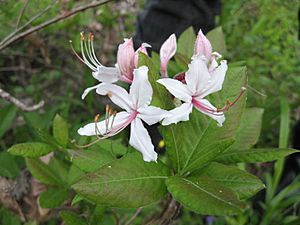Rhododendron periclymenoides facts for kids
Quick facts for kids Rhododendron periclymenoides |
|
|---|---|
 |
|
| Scientific classification | |
| Genus: |
Rhododendron
|
| Species: |
periclymenoides
|
| Synonyms | |
|
Rhododendron nudiflorum |
|
The Rhododendron periclymenoides is a beautiful shrub often called the pink azalea or pinxter flower. It belongs to the heath family, which includes many well-known plants. This plant grows naturally across eastern North America, from Alabama all the way up to New Hampshire. You can often find it near rivers or in forests that are either wet or dry.
In spring, this plant shows off its bright pink flowers. These flowers have long parts called stamens, about 2 inches long. They also have a strong, sweet smell, a bit like petunias. The leaves are a bright green color and shaped like an oval. The main stem, or trunk, can grow up to about 9 feet tall. It's important to know that, like many plants in the Rhododendron family, all parts of this flower contain natural substances that can be harmful if eaten.
People often grow this plant in their gardens because it's so pretty. There's even a possible sighting of this plant in O'Leno State Park in Columbia County, Florida, near the Santa Fe River.
Contents
What is the Pink Azalea?
The Rhododendron periclymenoides grows across the eastern parts of the United States. You can find it from southern New York down to Georgia. There are also some smaller groups of these plants in states in the Midwest. This plant likes to grow in certain places. It prefers the edges of swamps, damp woods, and open areas. It can grow well in full sunlight, partial sunlight, or even in light shade.
The best soil for the pink azalea is usually a bit sour, which means it's acidic. It also likes soil that has a lot of rich, dark material called humus. This kind of soil holds water well but also lets extra water drain away. You might find this plant in forests with oak and hickory trees, or with pine and spruce trees. Hummingbirds and butterflies are common visitors to the pink azalea, helping it to make new seeds.
How Did the Pink Azalea Get Its Name?
There are about 860 different types of plants in the Rhododendron family. The Rhododendron periclymenoides was first described by a scientist named Michaux. Another name for this plant, R. nudiflorum, was changed in 1962 to be a synonym, meaning it's another name for the same plant.
The Meaning Behind the Names
The name Rhododendron comes from two old Greek words. "Rhodo" means rose, and "dendron" means tree. So, it's like a "rose tree." One of its common names is "pinxterbloom azalea." The word "Pinxter" comes from a Dutch word for Pentecost. This is a special Sunday that happens seven weeks after Easter. The flowers of the pink azalea usually bloom around this time of year.
Is the Pink Azalea Safe?
The Rhododendron periclymenoides is a very interesting plant, but it's also important to know that all parts of it are poisonous. If someone were to eat any part of this plant, it could be very harmful. The harmful substances in Rhododendron plants are called grayanotoxins. These are natural chemicals that can affect how cells in the body work.
The specific grayanotoxin in the pink azalea is called andromedotoxin. If someone accidentally eats this plant, they might experience symptoms like a lot of drooling, stomach pain, throwing up, or trouble breathing. It's very rare for people to get sick from eating Rhododendron plants. However, pets and farm animals can sometimes eat parts of the plant.
Bees that collect pollen from Rhododendron plants can sometimes make "mad honey." This honey contains the same grayanotoxins. If people eat "mad honey," they might feel dizzy, have low blood pressure, or have other heart problems. While not common in the United States, some people in China believe "mad honey" has special health benefits.
Pink Azalea and Its Environment
Like many plants, the pink azalea can sometimes have problems with insects and diseases. Some common insects that can harm the pink azalea include aphids, tiny worms called nematodes, and whiteflies. Diseases that can affect it include root rot, leaf spot, and powdery mildew. Wild pink azaleas are often stronger and can fight off these problems better than the types grown in gardens.
Growing Pink Azaleas in Gardens
The Rhododendron periclymenoides is a popular plant for gardens because its flowers are so pretty. People often use it as a plant near their homes or to create borders in their yards. You can grow new plants from its seeds or from cuttings. If the soil in your garden has a lot of clay, it might not drain water well. In that case, experts suggest planting the azalea in raised garden beds. This helps prevent the roots from getting too wet and rotting.
Pink Azalea in Nature
Many animals and birds use shrubs like the pink azalea for shelter on the forest floor. The roots of these plants also help to hold the soil in place. This is important because it stops the soil from washing away, especially near rivers and streams. This also helps protect the quality of the water in these areas.
Pink Azalea and Wildfires
When wildfires happen, they often burn the top parts of azalea plants. However, the United States Forest Service says that after a fire, the Rhododendron periclymenoides can grow back. It can resprout from parts of the plant that are hidden underground.
Images for kids


